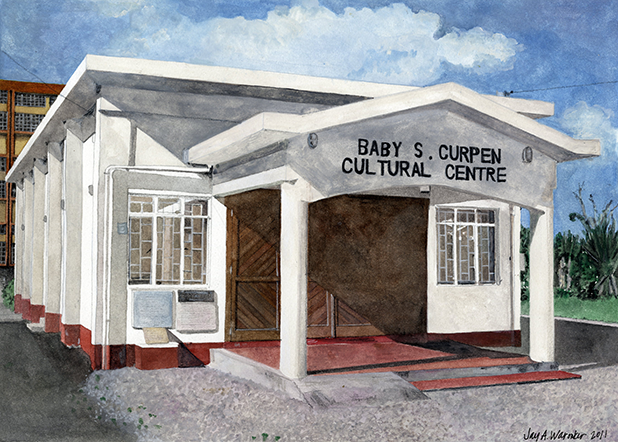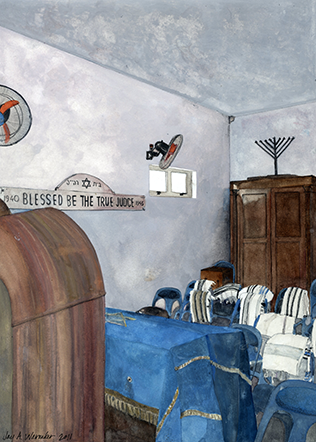 Exterior View (2011), 15” x 11” Watercolor, Jay A. Waronker
Exterior View (2011), 15” x 11” Watercolor, Jay A. Waronker
MAURITIUS
Baby S. Curpen Cultural Center Synagogue (Completed in 2006) |
|

Interior View (2011), 11” x 15” Watercolor, Jay A. Waronker
|
The first Jews to Mauritius, from Central and Eastern Europe, arrived on passenger ships during the turmoil of World War II and Nazi aggression in late 1940. Included in this wave were German Jews along with Austrians, Danes, Poles, and Czechs. When these 1,580 refugees had been denied entry to Palestine by the British Government as dictated by the White Papers, they sought haven wherever possible, and Mauritius then under British rule and after careful review by the authorities offered them haven. In time most of these Jews, who were living in detainment centers, chose to leave when conditions allowed them to finally immigrate to Palestine. The Jews that came to establish a small community in Mauritius in later decades therefore did not come in masse but in trickles from a variety of places – although mostly from Europe – and for an assortment of personal and professional reasons. According to the population census 2011, there were about forty three-Jews living on the seemingly idyllic Island of Mauritius, which includes long-standing residents, expatriates, and diplomatic staff.
As in so many places, the Jews of Mauritius did not immediately have a synagogue to pray in and base themselves. They instead conducted prayer services and gathered for activities in private homes or temporary facilities. It was in fact some decades before a formal Jewish center was planned and built. The Curpen Center came into being during the first decade of the twenty-first century as a combined venture of the Israel-Mauritius Friendship Club, the Amicale Maurice Israel, the local Jewish community, and overseas donors with a connection with the country and its Jewish past. The Center is located in a quiet and somewhat isolated gated site in the town of Curepipe, located in both the Plaines Wilhems and Moka Districts at almost the dead center of Mauritius. The building includes a communal hall seating two hundred people at the front of the building along with an office and open kitchen. To the rear of the building is a separate quite small sanctuary that can accommodate some dozens of congregants.
This Jewish facility was built on a plot of land specially provided free of charge by the government of Mauritius. A local community leader and unofficial ambassador between Mauritius and Israel, Baby S. Curpen, had lobbied the government for the building site. For his successful effort, the building was named in his honor. A formal dedication ceremony of the center took place in 2006, and it was renamed a few years later in Curpen’s honor. The opening of the center was attended by members of the community, Rabbi Moshe Silberhaft of the African Jewish Congress based in Johannesburg, South Africa as the so-named “travelling rabbi,” and invited guests from the local religious, political, and civic communities.
The unassuming gabled-roofed Curpen Cultural Center is a modest and utilitarian symmetrical structure constructed of concrete and concrete block painted white, and it features a wide and deep front porch. The Curpen Center’s understated aesthetic containing no Jewish symbols or even expressive or identifying architectural forms makes it difficult to recognize it as a synagogue or even a special civic building. Only the bold block lettering affixed to the front façade gives its function away. The open land to the front and sides of the free-standing structure, fronted by a gate along the minor street, is used for parking as well as a gathering spot for holiday events and activities.
 Interior View (2011), 15” x 11” Watercolor, Jay A. Waronker
Interior View (2011), 15” x 11” Watercolor, Jay A. Waronker
Baby S. Curpen Cultural Center Synagogue |
|
|
The Jewish center and synagogue, the only in Mauritius and completed in 2006, measures 23’ x 47’ with a communal hall with open office and kitchen located in front that is divided by a solid wall with one door to the prayer space to the rear. It is unclear why the sanctuary is so small, even claustrophobic, but this dedicated space seems to not been part of the original building design. Yet the building could have been better subdivided since the communal hall is so generously sized and the prayer space so compact. Even though the Jewish community of Mauritius numbers less than fifty people, a more open prayer space would have been more practical and made the experience of being in the space more welcoming and pleasant.
The prayer space is an especially non-descript narrow room finished in plaster walls painted white, ceramic floor tiles, flat ceiling, and small metal casement windows. The room is furnished with plastic chairs, some Jewish art and World War II memorabilia decorating the walls, a wooden storage cabinet, freestanding bimah draped in a heavy fabric, and a wall-hung wooden Ark. At the time of the painting, the Ark was not properly hanging from the wall but was sitting on the floor waiting to be positioned.
